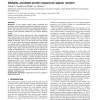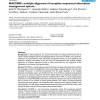15 search results - page 3 / 3 » Structural proteomics of the poxvirus family |
BIOINFORMATICS
2010
13 years 6 months ago
2010
Motivation: To test whether protein folding constraints and secondary structure sequence preferences significantly reduce the space of amino acid words in proteins, we compared th...
BMCBI
2006
13 years 6 months ago
2006
Background: Whole genome sequence data is a step towards generating the 'parts list' of life to understand the underlying principles of Biocomplexity. Genome sequencing ...
BMCBI
2006
13 years 6 months ago
2006
Background: In the post-genomic era, systems-level studies are being performed that seek to explain complex biological systems by integrating diverse resources from fields such as...
BMCBI
2004
13 years 5 months ago
2004
Background: The increasing number of protein sequences and 3D structure obtained from genomic initiatives is leading many of us to focus on proteomics, and to dedicate our experim...
BMCBI
2005
13 years 6 months ago
2005
Background: The SH3 domain family is one of the most representative and widely studied cases of so-called Peptide Recognition Modules (PRM). The polyproline II motif PxxP that gen...


